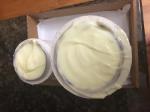Understanding the different yet similar oils is really getting confusing
by SJ
(Arizona)
If a recipe calls for vegetable shortening AND soybean oil, can I just add the two measurements together and use the shortening or do I need to find another substitute for one of them? (is there just soybean oil?)
I also heard that coconut oil can be substituted for palm oil, but I wasn't sure if you just combine the two measurements if a recipe calls for both but you only have coconut oil. I am trying to stay away from palm oil altogether and don't understand the oils enough to know what the best substitutes are and for what!
Answer:
If a recipe calls for both soybean oil and vegetable shortening, you cannot just add the two measurements together and carry on.
When you make any changes to a handmade soap recipe, you must use a lye calculator to re-formulate the recipe and get the new corrected amount of lye that is needed. There is no way around this step...it is crutial to the success of the soap and to your safety when it comes time to use the soap.
SoapCalc is the lye calculator that I use and it is quite simple. Don't be intimidated by it...all you have to do is read the tutorial and click on the numbered squares to figure out how to use it.
Crisco is the vegetable shortening that is on Soapcalc and has a SAP value (saponification value) listed. Just be aware that vegetable shortening is usually made with palm oil.
Soya bean oil is available from soap making suppliers and can be used in soap making.
The characteristics of soya bean oil (or olive oil, apricot kernel oil, almond oil, rice bran oil, avocado oil, grapeseed oil, hempseed oil, etc.) will provide a thin conditioning lather. These ingredients are added because of their great skin conditioning abilities.
The characteristics of palm oil (or lard, tallow, shea butter, cocoa butter, mango butter) will add strength to the soap and a stable and conditioning lather. These ingredients tend to thicken the lather up making it creamier.
The characteristics of coconut oil (or palm kernel oil or babassu oil) provide big fluffy bubbles and make the soap really hard.
As I mentioned in an earlier post to you, visit my page on Soap Making Oils and read the following headings:
Formulating a Recipe
Bring on the Bubbles
Condition Me
The Anomaly
Love that Creamy Lather
These paragraphs explain how I create recipes and what oils will act similarily in the final soap.
Hope that helps,
Cathy

